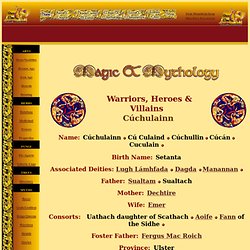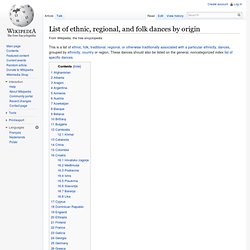

Mythologie - cosmogonie. Greek Mythology.
Index of Celtic Gods. Celtic Warrior Cuchulainn. The Celtic method of single combat in battle situations Although a large army of men and women set out to do battle, combat was primarily undertaken on a one to one basis.

Warriors were chosen from each side who would engage in combat with each other. The outcome would determine which side had won or lost. This was seen to be preferable to all out combat in which many lives were lost regardless of whoever was ultimately victorious. It was considered the height of barbarism to waste human life needlessly when heroic champions were an integral part of Celtic culture and had thus been specifically trained in the warrior arts - it was the champions role to fight on behalf of many people rather than just themselves. This was how Cúchulainn came to defend Ulster single-handedly, instead of being overwhelmed by the sheer numbers of the army of Queen Medb of Connaught he defended his position by fighting warrior after warrior in single combat.
Further Reading: Hull, E. Kinsella, T. Newark, T. List of ethnic, regional, and folk dances by origin. This is a list of ethnic, folk, traditional, regional, or otherwise traditionally associated with a particular ethnicity, dances, grouped by ethnicity, country or region.

These dances should also be listed on the general, noncategorized index list of specific dances. Afghanistan[edit] Attan Albania[edit] Aragon[edit] Argentina[edit] Armenia[edit] Austria[edit] Azerbaijan[edit] Basque[edit] Bastan Danza Belarus[edit] Lawonicha (Lyavonikha) Folk Art, Traditional Crafts: History, Characteristics. Positive Bead Crafts- African Folklore Embroidery Traveling Exhibition - African Safari. BEADED AFRICAN VILLAGE, - Positive beadwork and the Rainbow nation Perceptions and associations of Africa frequently revolve around drought, starvation and AIDS.

I wanted to design a piece that reflected the artistic and diverse cultural beauty of South Africa. While I love living in America I continue to feel a deep love and affiliation towards the country of my birth. My work while living in South Africa involved research into different tribal communities and sharing those findings amongst all groups to facilitate greater understanding and communication. This research allowed me to develop an appreciation for the art forms practiced by each tribe.
In designing this quilt, I wanted to incorporate the various cultural practices and art forms of the different tribes. I embroidered the designs using African –hand –dyed threads. Highlighting AIDS in South Africa is part of my mission. Art Folklore and Craft of Cuzco. Calendar of Feast and Festivals of Cuzco Cuzco Cuisine Folklore in Cuzco Cuzco is a universe of dances, inheritance from the Inca times and that they also conserved from all the towns and nations that conquered.

Many of their dances also have the inheritance of Spain, with great influence of the Christian religion. Today's religious feasts, give origin to the big dances where fine dresses, beautifully decorated and embroidered, with multicolored suits are worn, accompanied by their music and song. In Cuzco's rural areas, the way people dress makes an important distinction, as a result of the blend of pre-Hispanic influences with the European clothing that the natives were forced to wear during the colonial era. The Music & Dances, thanks to the recent archaeological discoveries of musical instruments, experts now know that in Peru, music has been played at least as far back as 10,000 years ago.
Festivals and rituals in Cuzco: Cuzco celebrates some hundreds festivals a year. Dutch folklore and traditions - Dutch Countryside. Folklore is based on customs and conventions from the past, but eventually the present also becomes part of the past: that is why folklore is in a constant state of evolution.

Folklore is more than traditional costumes and songs; it is the collective name for all the stories, songs, habits and crafts that are still alive in people’s minds and that can sometimes still be practiced or recognised in contemporary customs Present meets past The best day to be introduced to Dutch folklore is 30 April: Queen’s Day. Once this was a small event, but under the current monarch (Queen Beatrix) it became a national festivity.
Each year, the Queen and her family visit one or two places in the Netherlands, where they are received with special celebrations, organised by the local population. Traditional costumes These days we only see traditional costumes during folkloric events, but the tradition is very old. Mills Fairs and markets The Netherlands have a rich history as a trade nation. Cheese markets. Encyclopedia Mythica. Folk stories.